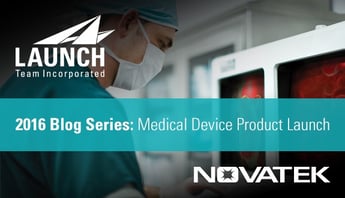
 Launch Team is collaborating with technical documentation and training company Novatek to explore marketing and product launch challenges in the medical device industry.
Launch Team is collaborating with technical documentation and training company Novatek to explore marketing and product launch challenges in the medical device industry.
In this interview with Paul Thomas, Development Director of Cupris Health, we explore the barriers, strategies and tactics for medical device product launch. Cupris, located in the UK and looking to enter the US market, has developed communication software and smartphone-connected medical devices that enable remote diagnosis and management of patient conditions.
Michele: Telemedicine changes the way physicians engage with patients. What are you seeing as barriers to the shift? What practices are physicians or hospital systems utilizing to keep the quality of the relationship intact and valued?
Paul: The principle barriers to the shift (in my opinion) are organisational, cultural and regulatory.
Organisationally, even if most doctor’s offices and hospitals are overwhelmed, changing well-established working practices is a challenge. The two main aspects of this are funding and time. Doctors and other healthcare professionals (HCPs) are usually paid to see patients. In order to undertake remote or online consultations, appropriate funding mechanisms need to be in place. In addition, even if remote consultations are more efficient and shorter, you’ll need to dedicate some time in your day to deal with them. The structures need to provide time in the HCP working day to deal with telemedicine. If hospitals aren’t paid for this work, they are less likely to provide time for their staff to do it.
Culturally, changes from seeing a patient in person to attending to them remotely is a change in practice that some HCPs may not be comfortable with. They may feel they can miss key information for their decision-making process by not seeing the patient. However, this is less and less true as our communication has already changed in most of the other fields of our lives and people are more reassured about the completeness of remote communication than they were in the past. In addition, HCPs can always ask the patient to come for a face-to-face consultation if they have any doubts.
From a regulatory perspective, information governance issues present significant barriers to entry, are time-consuming and are often open to interpretation, making this a difficult area to manage.
Your device changes your customer base as well (broader base of physician and parent users, needs and user environments). What's the impact to your medical device sales approach? How are you seeking to improve customer engagement pre- and post-sale?
Time will tell, but the research available suggests that most patients are comfortable with the concept of remote care. I believe that most prioritise the resolution or management of their healthcare issue and convenience over seeing a doctor in person at every stage. The use of video clips and audio can help to maintain and develop relationships between doctors and patients. The Cupris system also provides the patient with greater autonomy in the management of their healthcare issues.
In terms of customer engagement, Cupris has a targeted approach and offers different user environments and processes to be able to address different needs.
In product development, how did you go about learning the needs of such a diverse user base?
User-centred design has played a key role in our product’s development. Health specialists such as doctors, surgeons and caregivers along with patients and parents have been heavily involved in our development process from concept design through to testing, trials and validation and are constantly giving feedback and inputs on our product development.
What do you see as the driver for the paradigm shift there? And in the States?
As populations age and grow, healthcare in its current form is financially unviable in the western world; health services simply can't afford to pay the ever rising costs. Patient waiting time has also increased considerably due to the increased workload placed on health specialists. In addition, patients are now used to managing by themselves most of their daily activities in a wide range of fields such as travelling, banking and shopping. The shift has already operated in most of the other industries and is one of the main drivers for this shift to happen in healthcare. Eventually, more and more patients will want to understand and be empowered to make decisions about their healthcare.
In the developing world it's a different issue. In India, for instance, the vast majority of healthcare is located in urban centres whereas the population is predominantly rural; people are simply not receiving the care they need. Cupris is developing mobile medical devices and a health care service that allows patients to be diagnosed remotely. This has obvious benefits in the developing world and can provide millions of people with healthcare that previously didn't exist.
Thanks, Paul! To learn more about Cupris Health, visit Cupris.com.
Read our previous post on Ensuring Customer Engagement in Telemedicine.
For more ways to improve engagement, download our 10 Tips for Connecting with Medical Device Customers.

